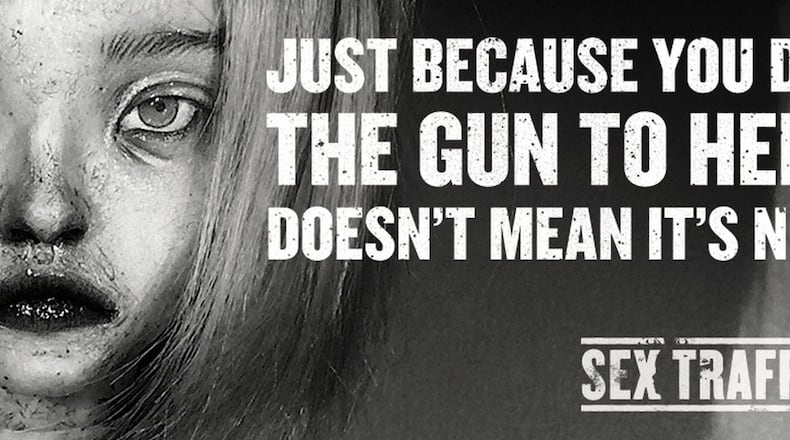There’s a parable about a villager who one day spots a drowning baby and pulls it from a river. The next day, he sees two more and snatches them from the same swift waters. The following day, four babies are caught in the turbulent current. And then eight, then more, and more.
Deborah Richardson, executive director of the International Human Trafficking Institute, retold the story recently to make a point. It's time, she said, we addressed the root cause of sex trafficking — demand.
For far too long, our advocacy and law enforcement efforts have focused on the arrest and prosecution of traffickers, while those who were driving the market demand of exploited children were ignored.
Richardson hopes a new digital billboard campaign her agency launched May 21 will finally do the trick.
Having seen those billboards, I don’t see how it couldn’t.
“The Truth in Trafficking,” which will run through June 16, is the brainchild of Legend ad agency CEO Michael Dunn.
The billboards, he said, were designed to get into the predator’s mind, deconstruct his motivations and destroy his justifications. He doesn’t see his behavior as destructive but rather transactional. He has blinded himself to the truth, the horrors he creates, the irreparable damage he does to these innocent children who have absolutely no choice — and never have.
“When you look at a child who has been trafficked, you can’t see the abuse, the deterioration of their souls,” Dunn said. “It’s time we expose the truth, so we are turning up the volume on both the voice and vision with a campaign that sheds light on the pain these children go through, day after day, purchase after purchase, up to eight times a day.”
Not only are we numb to that pain, Dunn said research shows predators rarely even see children as human but rather objects.
RELATED | Ever tried to imagine what it’s like to be exploited for sex?
Hence the dolls staring from the billboards. Dolls that appear skeletal. Dolls with bruises around their eyes. Dolls sitting blackened and bruised in a shower.
Each one communicating a message meant to make us think, feel, see the pain they feel once and for all.
“Once you’re in prison for raping me, you’ll see what it feels like.”
“You found me on the internet, your family will find you in jail.”
“Molested at 12. Sold by dad. Forced on drugs. Raped 8X a day.”
Who can see and read such moral scripts — even for a moment — and not be moved?
If you find them uneasy to look at, that’s the intended reaction. If you’re moved to do something, to demand something better for our children, even better.
Both Dunn and Richardson hope the billboards — scattered across 23 metro Atlanta locations from Cumming down to South Fulton, west Cobb to Gwinnett, and crossing Interstates 85, 285 and 20 — will spark questions and then conversations in communities and around dinner tables and eventually change.
RELATED | How this nonprofit is decreasing the demand for sex
There are some who have questioned whether human trafficking is as pervasive as Richardson and others have made it out to be, particularly in this city too busy to hate.
And so it might not surprise you that a national study by U.S.-based Demand Abolition, which campaigns against the sex trade, indicates only a small percentage of people — mostly men — buy sex with children, but here's the real problem: They do it a lot.
They are, in fact, responsible for 75 percent of the market. What might surprise most of you is here in Georgia, the majority of men buying sex with children live north of I-285. The vast majority have incomes of $100,000 or above. They’re privileged, upstanding businessmen.
“If we can get the public to come out of denial about who is perpetrating this crime, then there would be more outrage and a public will to arrest these predators,” Richardson said, “but because they operate in anonymity, there is no societal pressure to stop.”
Could it be because predators live, well, upstream and 75 percent of children who are trafficked are African American, living, of course, downstream?
Credit: The Atlanta Journal-Constitution
Credit: The Atlanta Journal-Constitution
Richardson thinks so. It’s why the parable of the river babies resonates with her so.
In the parable, the villagers organized quickly, setting up watchtowers and training teams of swimmers who could resist the swift waters and rescue babies. Over time, they began to feel they were doing well just to save as many as they could each day. The village priest blessed them for their good work, and life continued as usual.
It wasn’t until someone asked “Where are all these babies coming from?” that they organized a team to head upstream to find out who was throwing the babies in the river in the first place.
They finally figured out that if they went upstream, they could eliminate the cause of the problem.
After 20 years of trying to rescue children from the sex trade, Richardson has no doubt that the only way to stop human trafficking is to put an end to the demand.
“We can’t continue to put a Band-Aid on this,” she said. “This is a serious gaping wound in our city and our state, and we need to focus on the source of why it’s happening in the first place. We’ve got to go up the river with this.”
She’s right.
Find Gracie on Facebook (www.facebook.com/graciestaplesajc/) and Twitter (@GStaples_AJC) or email her at gstaples@ajc.com.
About the Author
Keep Reading
The Latest
Featured




